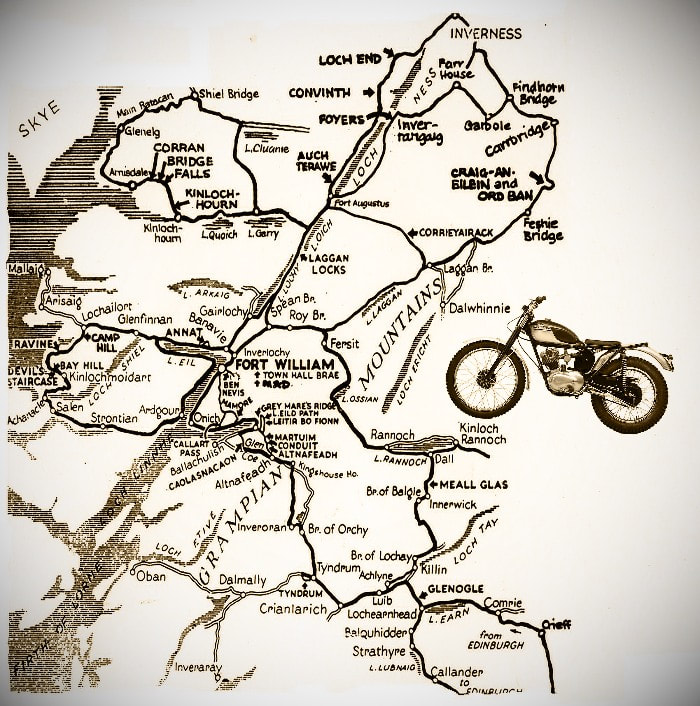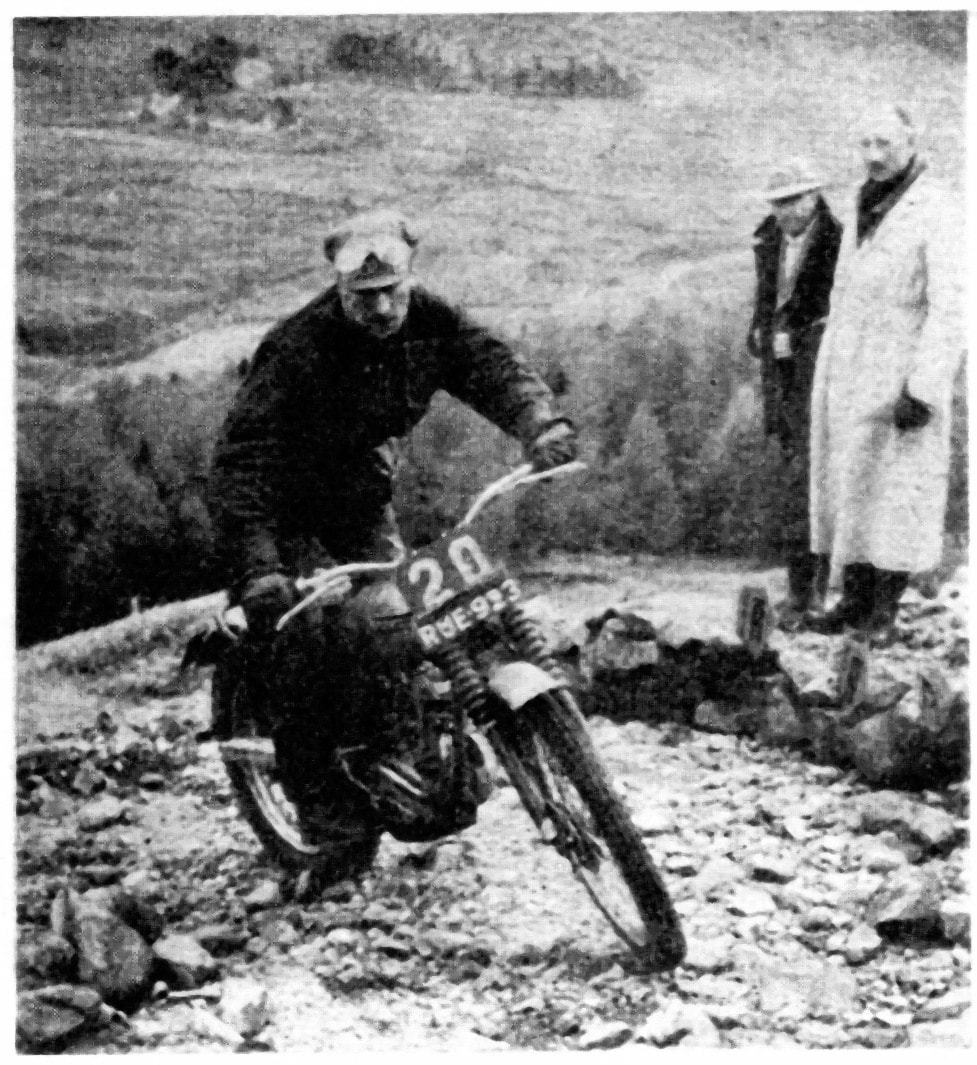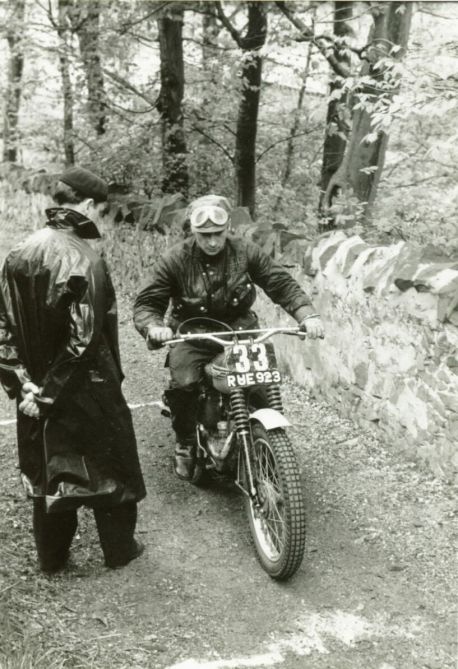Lightweight Avalanche in the Highlands
Following Ken Heanes' gold medal winning ride in the 1956 ISDT on a factory prototype twin-shock framed Tiger Cub, a T20C 'Competition Cub' based on that machine appeared in Triumph's 1957 sales brochures.
It was the first production Tiger Cub model to come out of the factory to really emphasise the off-road competition capabilities of the machine, and it certainly got the attention of the public.
At last here was a machine that may well be able to take on and beat the then traditionally accepted larger-engine trials bikes that had been the mainstay of competition for many years...
It was the first production Tiger Cub model to come out of the factory to really emphasise the off-road competition capabilities of the machine, and it certainly got the attention of the public.
At last here was a machine that may well be able to take on and beat the then traditionally accepted larger-engine trials bikes that had been the mainstay of competition for many years...
...and it certainly didn't disappoint! Over the following years Tiger Cubs took established stars to literally dozens of national and trade supported trials wins along with innumerable club-level wins by ordinary riders just out for a day’s sport.
Motorcycle trials started in Great Britain over 110 years ago back in the 1900's, although it's doubtful anyone actually knows the exact date of the very first event.
Not about speed, it's a test of riding skill, balance and concentration over observed sections which can contain rocks, boulders, steep slopes (both up and down), mud, streams and gullies.
Competitors must navigate the sections without putting their feet down or 'dabbing' as it's known. For every dab a point is added to their score, meaning the rider with the least points at the end of all the sections is the winner.
Most trials are one-day events, but a few stretch over a number of days and it's widely accepted the Scottish Six Days Trial (SSDT) is 'The One' to win. Held in the Highlands of Scotland the SSDT is run over six consecutive days with competitors riding anything up to 150 miles in one day and sometimes more.
Not about speed, it's a test of riding skill, balance and concentration over observed sections which can contain rocks, boulders, steep slopes (both up and down), mud, streams and gullies.
Competitors must navigate the sections without putting their feet down or 'dabbing' as it's known. For every dab a point is added to their score, meaning the rider with the least points at the end of all the sections is the winner.
Most trials are one-day events, but a few stretch over a number of days and it's widely accepted the Scottish Six Days Trial (SSDT) is 'The One' to win. Held in the Highlands of Scotland the SSDT is run over six consecutive days with competitors riding anything up to 150 miles in one day and sometimes more.
|
Pic. left - Area around which the SSDT was run Each day riders and their motorcycles take on a combination of rocky, boulder strewn tracks, streams, rough moorland and public roads in sometimes the worst weather the Scottish Highlands can throw at them and up until 1959, no lightweight machine had ever taken the victory there. But that was about to change... The Scottish was widely recognised by riders, factories and the motorcycle trade as the event to win and in 1959, Triumph entered a three-man team riding Tiger Cubs. The riders being Roy Peplow, Arthur Ratcliffe and Ray Sayer (substituting in the 'Works' team for Johnny Giles). |
|
The 1959 SSDT, held between the 4th -9th May, was the Golden Jubilee year and the first day consisted of a 149-mile route from Edinburgh to Fort William. After 22 sections the only rider with a clean score was Gordon Blakeway (500 Ariel), but he then mistook the route up Town Hall Brae and forfeited five marks. A similar mistake being made by Triumph 'Works' rider Arthur Ratcliffe. At the end of the day, the leader was Sammy Miller (500 Ariel) with a penalty of one. Second place was Ray Sayer (200 Triumph) on three marks followed by Roy Peplow (200 Triumph), A. J. Lampkin ((250 BSA) and G. L. Jackson (350 A.J.S.) all on four penalties. Manufacturers Team leader being Triumph (18 marks), then Ariel (19 marks) and A.J.S. (20 marks). |
|
The second day started rather unexpectedly for Arthur Ratcliffe (200 Triumph) who had to repair a flat rear tyre even before reaching the first section at Martuim, overlooking Kinlochleven. Twenty-five miles further on lay the six sub-sections at Tyndrum. In the cloud enshrouded snow-flecked mountains, the sections wound up the near vertical climb in a series of vicious hairpins over stone debris and jagged rocks left from disused lead workings. Here Roy Peplow on his Cub managed an incredible 'clean'. The day ended with four paired "subs" on the lower slopes of Ben Nevis with their narrow rock and mud-rut passages. Ray Sayer 'cleaned' it, Peplow lost his second mark and Ratcliffe stopped. |
At the end of the day the lead had been taken jointly by Roy Peplow (200 Triumph) and A. J. Lampkin (250 BSA) with a total of six marks lost.
In second place was G. L. Jackson (350 A.J.S.) 7 marks with third placed men Ray Sayer (200 Triumph), J. V. Brittain (350 Royal Enfield) and Sammy Miller both on nine.
Manufacturers Teams - A.J.S. 33; Triumph 34; James 53.
In second place was G. L. Jackson (350 A.J.S.) 7 marks with third placed men Ray Sayer (200 Triumph), J. V. Brittain (350 Royal Enfield) and Sammy Miller both on nine.
Manufacturers Teams - A.J.S. 33; Triumph 34; James 53.
|
Ray Sayer manoeuvres his Tiger Cub
up the rocks at Laggan Locks on the third day of competition |
The mountains around Loch Ness hosted the third day and 151 miles of fierce competition.
In perfect weather conditions Miller and Jackson took the lead from Peplow and Lampkin on the stony mountain side between Loch Lochy and Loch Oich, some twenty miles north east of Fort William. Peplow 'dabbing' on both the second and third sub-sections. Positions at the end of the day being: S. H. Miller (500 Ariel) and G. L. Jackson (350 A.J.S.) 10; R. S. Peplow (200 Triumph) 12; J. R. Sayer (200 Triumph) and S. R. Wicken (250 Francis-Barnett) 13. Manufacturers Teams - A.J.S. 52; Triumph 55; Ariel; 65. |
|
Roy Peplow balances his Tiger Cub
on Tyndrum's rocks |
Day four, and most of the sections lay on the 114-mile rocky coastal path from Lochailort to Kinlochmoidart. At the end of the day Jackson (350 A.J.S.) had 'cleaned' everything, the only person to manage the feat so far in the trial, and took the lead from Miller who had lost three marks. It wasn't the same for the rest of the A.J.S. team though and they slumped badly. The other members losing 10 (G. O. McLaughlan) and 27 (C. H. Clayton). The Tiger Cub trio of Ratcliffe and Sayer (one mark apiece) and Peplow (4) retaking the manufacturers lead by 27 marks. Day four results - G. L. Jackson 10; S. H. Miller 13; J. R. Sayer 14. Manufacturers Teams - Triumph 61; A.J.S. 89; Ariel; 96. |
The fifth day's route was only 66 miles long with 33 sub-sections, nearly half of them on the long Loch Eild Path climb which snaked its way over a boulder-strewn gulley overlooking Kinlochleven.
A night of heavy rain had made the terrain interesting as all eyes were trained on the Jackson-Miller-Peplow-Sayer struggle for supremacy.
As the day wore on the four riders approached the last few sections. On the 'L'-shaped last "sub", deemed one of the most difficult in the trial, a steep rock step worn away on the inside awaited the riders.
Peplow, who had lost only two marks so far, blipped the throttle of his Cub and 'cleaned' it. Miller had already 'dabbed' at Altnafeadh and needed another two 'foots' and a couple of prods on Loch Eild Path.
It was going to be close at the end of the day!
R. S. Peplow 18; G. L. Jackson 20; S. H. Miller 22; J. R. Sayer 27.
Manufacturers Teams - Triumph 79; Ariel 140; Royal Enfield 143.
A night of heavy rain had made the terrain interesting as all eyes were trained on the Jackson-Miller-Peplow-Sayer struggle for supremacy.
As the day wore on the four riders approached the last few sections. On the 'L'-shaped last "sub", deemed one of the most difficult in the trial, a steep rock step worn away on the inside awaited the riders.
Peplow, who had lost only two marks so far, blipped the throttle of his Cub and 'cleaned' it. Miller had already 'dabbed' at Altnafeadh and needed another two 'foots' and a couple of prods on Loch Eild Path.
It was going to be close at the end of the day!
R. S. Peplow 18; G. L. Jackson 20; S. H. Miller 22; J. R. Sayer 27.
Manufacturers Teams - Triumph 79; Ariel 140; Royal Enfield 143.
|
The final day consisted mainly of a 141 mile road run to Edinburgh and then a machine examination: and at long last a lightweight machine had won the' Scottish'. That superb fifth day performance by 22-year-old Roy Peplow and his Tiger Cub had clinched it by just two points from the previous year's victor Gordon Jackson on his 350 A.J.S. Picture right is from 1961 – The Stop and Restart Test at Blackford Hill Royal Observatory, Edinburgh on the path before the final machine examination. Here is Triumph works rider, R.S. ‘Roy’ Peplow on his 199cc Tiger Cub. The instructions were to ride beyond the first yellow ochre line then stop before the second line, then move off again when instructed by the official. In 1961 Roy Peplow lost 17 marks and gained a Special First Class award and Best performance on a solo motorcycle from 151 – 200cc. |
Cubs Sweep the "Scottish" proclaimed the headline in 'The Motor Cycle'. The most arduous event in the British trials calendar is the famous Scottish Six Days Trial, a thousand miles of rocky mountainous tracks in the Highlands.
Held first in 1909 - and won by a Triumph* - the 1959 event marked the Golden Jubilee - and it was again won by a Triumph, a Tiger Cub.
* That first 1909 event had been jointly won by H H Salvesen and S J K Thomson both riding 3.5hp Triumph machines.
Tiger Cubs in fact finished first, fourth and seventh, winning the Premier Award (Best Solo), the Manufacturers' Team Award and the 200cc class - a clean sweep. The winning rider was Roy Peplow and his team mates were Ray Sayer and Arthur Ratcliffe. The latter is seen in the picture above negotiating the notorious Loch Eild path while the ultimate winner, Peplow, on the right, watches him intently.
Not only that, Peplow had become the first person ever to win the coveted J. R. Alexander Challenge Trophy* on a machine of under 250cc.
*The J.R. Alexander Challenge Trophy as mentioned above was donated to the Edinburgh club by the Edinburgh Ford main dealers, whose chairman’s son Henry was the man to have driven a model T Ford car to the top of Ben Nevis (and back down again).
Starting on 9th May 1911, it took then four days to ascend and a further five to descend. A fantastic publicity stunt for the Ford Motor Company at that time!
And to put the icing on the Triumph cake, Peplow, together with Arthur Ratcliffe and Ray Sayer on their Cubs - three of only seven men to lose less than 40 marks - took the Blackford Challenge Trophy for the best performance by a manufacturers team.
Held first in 1909 - and won by a Triumph* - the 1959 event marked the Golden Jubilee - and it was again won by a Triumph, a Tiger Cub.
* That first 1909 event had been jointly won by H H Salvesen and S J K Thomson both riding 3.5hp Triumph machines.
Tiger Cubs in fact finished first, fourth and seventh, winning the Premier Award (Best Solo), the Manufacturers' Team Award and the 200cc class - a clean sweep. The winning rider was Roy Peplow and his team mates were Ray Sayer and Arthur Ratcliffe. The latter is seen in the picture above negotiating the notorious Loch Eild path while the ultimate winner, Peplow, on the right, watches him intently.
Not only that, Peplow had become the first person ever to win the coveted J. R. Alexander Challenge Trophy* on a machine of under 250cc.
*The J.R. Alexander Challenge Trophy as mentioned above was donated to the Edinburgh club by the Edinburgh Ford main dealers, whose chairman’s son Henry was the man to have driven a model T Ford car to the top of Ben Nevis (and back down again).
Starting on 9th May 1911, it took then four days to ascend and a further five to descend. A fantastic publicity stunt for the Ford Motor Company at that time!
And to put the icing on the Triumph cake, Peplow, together with Arthur Ratcliffe and Ray Sayer on their Cubs - three of only seven men to lose less than 40 marks - took the Blackford Challenge Trophy for the best performance by a manufacturers team.
Given the success the Tiger Cub was having in the field of sporting and competition events worldwide, a new model, the T20S was released in 1959.
Further building on the formula of the T20C model, the T20S (Sports Cub) was to change people's perception of lightweight motorcycles and set a trend that's still prevalent today. Lightweight go anywhere trail, off road and adventure bikes.
Further building on the formula of the T20C model, the T20S (Sports Cub) was to change people's perception of lightweight motorcycles and set a trend that's still prevalent today. Lightweight go anywhere trail, off road and adventure bikes.










